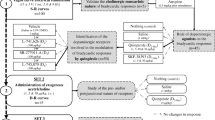Abstract
Available evidence suggests the existence of multiple categories of dopamine receptor1–4. According to the classification scheme used here5, dopamine receptors can be divided into two general categories, D-l and D-2. The dopamine receptors in the bovine parathyroid gland6–8 and carp retina9,10 exemplify the former category, and the dopamine receptors on the mammotrophs11,12 and melanotrophs13,14 of the pituitary gland exemplify the latter. Stimulation of a D-1 receptor enhances the formation of cyclic AMP, whereas stimulation of a D-2 receptor does not4,5. The availability of dopaminergic agonists which specifically activate either a D-1 or a D-2 receptor would facilitate pharmacological investigation of the physiological responses to dopamine; however, to date, an agonist specific for the D-2 receptor has not been available. Dopamine and other catecholamines stimulate both types of receptor6–14; ergolines (such as lergotrile and lisuride) stimulate the D-2 receptor13–15 but antagonize the D-1 receptor8,16–18; some agonists acting on the D-2 receptor (such as apomorphine) both stimulate and block the D-1 receptor6,8. Although one report claims that S-584 may selectively stimulate the dopamine receptor on mammotrophs19, according to another, S-584 stimulates the striatal dopamine-sensitive adenylate cyclase20. Several recently synthesized compounds containing various portions of the ergoline ring system stimulate the D-2 receptor on mammotrophs21. We report here that one of these ergoline analogues, LY-141865 or ‘38, R = pro’21, stimulates the D-2 receptor in the intermediate lobe (IL) of the rat pituitary gland but does not interact with the D-1 receptor in carp retina.
Similar content being viewed by others
References
Cools, A. R. & Van Rossum, J. M. Psychopharmcologia 45, 243–254 (1976).
Titeler, M., Weinreich, P., Sinclair, D. & Seeman, P. Proc. natn. Acad. Sci. U.S.A. 75, 1153–1156 (1978).
Costal, B. & Naylor, R. J. Life Sci. 28, 215–229 (1981).
Spano, P. F. et al. in Dopaminergic Ergot Derivatives and Motor Function (eds Fuxe, K. & Calne, D. B.) 159–171 (Pergamon, Oxford, 1979).
Kebabian, J. W. & Calne, D. B. Nature 277, 93–96 (1979).
Brown, E. M., Carroll, R. J. & Aurbach, G. D. Proc. natn. Acad. Sci. U.S.A. 71, 1113–1117 (1977).
Attie, M. et al. Endocrinology 107, 1776–1781 (1980).
Brown, E. M. et al. Molec. Pharmac. 18, 335–340 (1980).
Redburn, D., Clement-Cormier, Y. C. & Lam, D. M. K. Life Sci. 27, 23–31 (1980).
Watling, K. J., Dowling, J. E. & Iversen, L. L. Nature 281, 578–580 (1979).
MacLeod, R. M. in Frontiers in Neuroendocrinology Vol. 4 (eds Martini, L. & Ganong, W. F.) 169–194 (Raven, New York, 1976).
Caron, M. G. et al. J. biol. Chem. 253, 2244–2253 (1978).
Munemura, M., Eskay, R. L. & Kebabian, J. W. Endocrinology 106, 1795–1803 (1980).
Munemura, M. et al. Endocrinology 107, 1676–1683 (1980).
Cote, T. E. et al. Endocrinology 107, 108–116 (1980).
Kebabian, J. W., Calne, D. B. & Kebabian, P. R. Commun. Psychopharmac. 1, 311–318 (1977).
Schmidt, M. J. & Hill, L. E. Life Sci. 20, 789–798 (1977).
Pieri, L., Keller, H. H., Burkard, W. & DaPrada, M. Nature 272, 278–280 (1978).
Mowles, T. F., Burghardt, B., Burghardt, C., Charnecki, A. & Sheppard, H. Life Sci. 22, 2103–2112 (1978).
Miller, R. J. & Iversen, L. L. Naunyn-Schmiedebergs Archs Pharmak. 282, 213–216 (1974).
Bach, N. J. et al. J. med. Chem. 23, 481–491 (1980).
Cote, T. E., Grewe, C. W. & Kebabian, J. W. Endocrinology 108, 420–426 (1981).
Watling, K. J. & Dowling, J. E. J. Neurochem. 36, 559–568 (1981).
Spano, P. F., Stefanini, E., Trabucchi, M. & Fresia, P. in Sulpiride and Other Benzamides (eds Spano, P. F. et al.) 11–31 (Raven, New York, 1979).
Setler, P. E., Sarau, H. M., Zerkle, C. L. & Saunders, H. L. Eur. J. Pharmac. 50, 419–430 (1978).
Thorner, M. O., Fluckiger, E. W. & Calne, C. B. Bromocriptine: A Clinical and Pharmacological Review, 1–189 (Raven, New York, 1980).
Brown, B. L. et al. Biochem. J. 121, 561–562 (1971).
Lowry, O. H., Rosebrough, N. J., Farr, A. L. & Randall, R. J. J. biol. Chem. 193, 265–275 (1951).
Author information
Authors and Affiliations
Rights and permissions
About this article
Cite this article
Tsuruta, K., Frey, E., Grewe, C. et al. Evidence that LY-141865 specifically stimulates the D-2 dopamine receptor. Nature 292, 463–465 (1981). https://doi.org/10.1038/292463a0
Received:
Accepted:
Issue Date:
DOI: https://doi.org/10.1038/292463a0
- Springer Nature Limited
This article is cited by
-
Exploring neurocircuitries of the basal ganglia by intracerebral administration of selective neurotoxins
Neurotoxicity Research (2007)
-
Effects of dopamine D-1 and D-2 receptors on intraocular pressure in conscious rabbits
Journal of Neural Transmission (1997)
-
Behavioural effects in the rat of the putative dopamine D3 receptor agonist 7-OH-DPAT: comparison with quinpirole and apomorphine
Psychopharmacology (1996)
-
Evidence for genetically mediated dysfunction of the central dopaminergic system in the stargazer rat
Psychopharmacology (1996)
-
Potentiation of dopamine-dependent locomotion by clonidine in reserpine-treated mice is restricted to D2 agonists
Journal of Neural Transmission - Parkinson's Disease and Dementia Section (1994)





